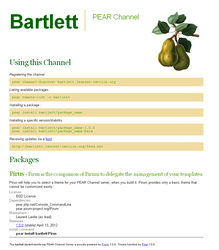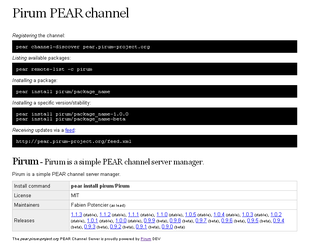This simple tutorial will demonstrate how to manage your pirum server with your own template.
What is included
Pirus comes with the same features as Pirum, which is almost the same code. Pirus add ability to handle your own templates easily, with a sample configuration file.
This configuration file is named pirum.ini (for windows users), and .pirumrc (for linux users).
Don’t be confused, between the two names Pirum and Pirus. Pirus 2.0 is only the behavior missing to Pirum 1.x
It’s the same interface, commands, as Pirum. After all it’s not a surprise, because Pirus 2 is a forked code of Pirum 1.1.5-dev
Structure of Configuration File
To handle multiple server and different graphical theme, it’s a pain and a maelstrom to do it with Pirum.
You have to switch from a copy of your templates/ directory to another.
With Pirus 2.0 and a simple INI file, that should exist in the same directory as the pirus script itself, like that :
[pirum]
template = default
templatedir = templates
;[/path/to/your/pear/channel/server]
;template = subfolder_of_templatedir
;templatedir = /path/to/your/templates
You have the same behavior as Pirum 1.1.4
This INI file is only a list of section, where each one define a single server and it’s location (on your file system), and the theme (template) to apply.
Migrate from Pirum to Pirus
Only two easy steps are required.
-
First, write a simple INI content file like the one below and named it following the platform rules :
pirum.ini(for windows users), and.pirumrc(for linux users). It must be located in the same directory as pirus executable. -
Second, just use pirus command rather than pirum
[pirum]
template = default
templatedir = templates
Add your first template
As Pirum, to get you started, you can copy and paste the default templates
found in the buildIndex() and buildCss() methods. Or just copy the default theme
in the templates/default directory of Pirus.
Suppose your PEAR Channel Server is locate in /var/pirum/servers/mypearchannel,
you’ve named it mypearchannel and you named the theme lightgreen.
Your configuration file should look like this one :
[pirum]
template = default
templatedir = templates
[/var/pirum/servers/mypearchannel]
template = lightgreen
In summary, your new file system structure will be :
+-- pirus
+-- templates/
+-- default/  | +-- index.html
| +-- pirum.css
+-- lightgreen/
| +-- index.html
| +-- pirum.css
+-- lightgreen/  +-- index.html
+-- pirum.css
+-- index.html
+-- pirum.css
| The default theme of Pirum | |
| You own templates html and stylesheet |
Advanced usage
If you want to separate location of your different themes and servers, you can
use another templatedir directive to do so.
Split templates directory in two groups : distribution files and your own files
[pirum]
template =
templatedir = templates
[/var/pirum/servers/myfirstpearchannel]
template = lightgreen
templatedir = /var/pirum/templates
[/var/pirum/servers/mysecondpearchannel]
template = ocean
templatedir = /var/pirum/templates
Your file system will look like :
/usr/local/php/pear/
+-- pirus
+-- templates/  +-- index.html
+-- pirum.css
/var/pirum/templates/
+-- lightgreen/
+-- index.html
+-- pirum.css
/var/pirum/templates/
+-- lightgreen/  | +-- index.html
| +-- pirum.css
+-- ocean/
| +-- index.html
| +-- pirum.css
+-- ocean/  +-- index.html
+-- pirum.css
+-- index.html
+-- pirum.css
| The default theme of Pirum | |
| lightgreen theme for your PEAR Channel Server | |
| ocean theme for your PEAR Channel Server |
Examples
The PEAR Bartlett Channel is the first one that use Pirus.

http://bartlett.laurent-laville.org/
bartlett template is based on the Pirum default template.
